The 25 Most Famous Paintings of All Time!
Hey folks! Transparency Disclosure- Some of the links in this article are affiliate links. That means I'll receive a small commission if you decide to click on it and buy something. Don't worry, it doesn't toll you anything extra!
Fantastic artwork is all effectually us. Some paintings are so ingrained in our cultural iconography that we meet them displayed in popular culture and don't even always get that there's a famous painting backside it. Others are household names that fifty-fifty the most disinterested in fine art could point out.
To celebrate these paintings, we've developed a list of the most important artworks of all time. Many of these paintings will be easily recognizable by proper noun, others past sight, or numerous pop culture references.
Some of the paintings on this list are obvious; others might not be and then. They range throughout history, from the thirteenthursday century to the xxthursday century. Some were created past the nearly famous artists of all time, while others are 1-hit wonders of the art world.
Here are the nigh famous paintings of all fourth dimension.
The 25 Most Famous Paintings of All Time
The Son of Man (Renee Magritte, 1964)
This surrealist painting features an image of a dapper homo wearing a concern accommodate with an apple in front of his face. The imagery and title instantly connect the work to the biblical story of Adam and Eve, where the apple is oftentimes considered the forbidden fruit that led to man's autumn.
Magritte considered The Son of Man to be a cocky-portrait. The apple purposefully simply partially hides the confront, and Magritte was trying to showcase that humanity can become obsessed with trying to see the hidden things that might be right outside of our views.

Image source: Wikipedia
The Son of Man is currently in a private collection
Las Meninas (Diego Velazquez 1656)
Las Meninas (The Ladies in Waiting) is an epic work depicting the children of the Spanish court. The central figure of the painting is Margaret Theresa, then age 5, girl of King Philippe Four.
The painting is renowned for its intricacies and details in limerick. Velazquez painted himself in the groundwork as a viewer to the scene, looking towards the viewer of the painting, which offers a unique perspective of the artist watching the viewer. Additionally, the King and Queen are in the prototype, merely only every bit modest reflections in the mirror on the wall, which creates the impression that they are standing with the viewer, seeing the scene unfold in the same fashion.
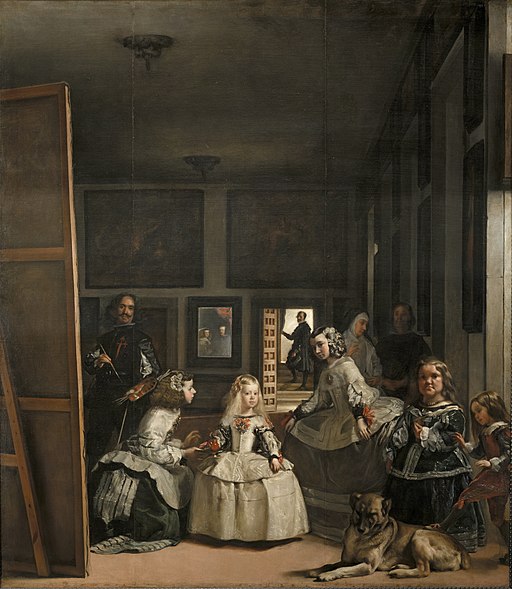
Las Meninas is on display at the Museo del Prado in Madrid
Girl with a Pearl Earring (Johannes Vermeer, 1665)
Girl with a Pearl Earring is a masterpiece from the Dutch Golden Historic period. Although this menses besides includes Rembrandt, a more well-known artist, Girl with a Pearl Earring is often more widely historic in art history and current civilisation than most of Rembrandt's works.
The painting depicts a immature girl wearing an orange-tinted dress and blue turban, with the namesake pearl earring dangling from an ear. The clothes is non typical of the period and location, which gives the daughter a sense of exotic intrigue.
Oft referred to as the Dutch Mona Lisa, Daughter with a Pearl Earring is frequently referred to and parodied in pop civilisation. Famous stand-ins include Marge Simpson, Squidward, and Kermit the Frog, in add-on to a multifariousness of people and animals. Even the famed street artist Banksy parodied this painting in spray pigment, replacing the earing with an alarm box.

Girl with a Pearl Earring is on display at Mauritshuis, The Hague, Netherlands.
Madame X (Madame Pierre Gautreau) (John Vocaliser Sargent, 1183-1884)
Madame X is wildly regarded every bit Sargent's best piece of work. It depicts Madame Pierre Gautreau, an American socialite in Paris, in an elegant black wearing apparel and standing in what was considered a sexually suggestive pose.
The original painting was scandalous. Sargent's original composition depicted one shoulder strap falling off the shoulder in what was a highly suggestive scene at the time. The poor reception led Sargent to revise the painting with an intact strap, which is how it is currently displayed.
Although an embarrassment for both Sargent and the model Gautreau at the time, the scandal led to the painting'southward (and arguably the artist's) notoriety. Art scholars and historians debate why the artwork was received so poorly and examine it within the lenses of history, politics, and high club at the fourth dimension.

Madame X is on display at the Metropolitan Museum of Art, New York.
Dogs Playing Poker (Cassius Marcellus Coolidge, 1894)
Information technology might be odd to see Dogs Playing Poker on the list of about famous paintings in the world. In that location is no uncertainty that other paintings are meliorate and more influential, simply ofttimes fame isn't about beingness good; it'southward nearly existence well known. Dogs Playing Poker is one of the about well-known paintings of all time.
What might not exist well known is that it is more than one painting. The original was created in 1894, and in that location are xviii versions of the series. Coolidge was commissioned to create these to annunciate cigars, but they became pop civilization icons and still are today.
This painting has appeared in shows such as Cheers, Roseanne, and The Simpsons. It's appeared in commercials, on anthology covers, and in film. The imagery of this painting is everywhere. Information technology's then ubiquitous that many of us don't realize that the original work was created in the 1800s.

The original "Poker Game" is currently in a individual collection.
Nighthawks (Edward Hopper, 1942)
Although it might not be known past name, the 1942 work past Edward Hopper is known well past the imagery. Nighthawks is the painting that features a diner with 4 people inside, lighting an otherwise empty and abased street.
This painting is often parodied and reimagined for pop civilization. The most famous rendition is Gottfried Helnwein's 1984 affiche, Boulevard of Broken Dreams, which replaces the original patrons with Hollywood's dearly departed stars of the 1950s – Humphry Bogart, Marylin Monroe, Elvis Presley, and James Dean.
Nighthawks has been featured and parodied in a diverseness of media. Poems and short stories have been written almost the patrons, and it's been featured in television shows from the Simpsons and That lxx's Evidence to CSI.

Nighthawks is currently on brandish at the Art Found of Chicago.
No 5 (Jackson Pollack, 1948)
Pollack's drip paintings are non known by name. It's hard to call up a proper noun when it's merely "No v" or "No vii". However, the imagery and fashion from the drip paintings are iconic, regardless of what nosotros call information technology.
No 5 was chosen for this listing because it is ane of the most expensive paintings sold. In 2006, it sold for 140 million and was the summit-grossing painting at the time (and is still in the top x!). Number 11, Blue Poles, is most equally as famous.
Pollack's drip paintings changed the face of art. Their 1949 feature in Life Magazine thrust abstract expressionism into the mainstream and started an unabridged motility. Nosotros tin trace near of the baste painting imagery we see in pop culture to Pollack's work. These paintings are famous fifty-fifty without world-renowned names.

No 5 is currently in a individual collection.
Guernica (Pablo Picasso, 1937)
Guernica is one of the most famous paintings by the world-renowned cubist Picasso. Created in response to the bombing of Guernica, Kingdom of spain, by the Germans in World War II, the painting is a haunting reminder of the pain and suffering caused by war.
This piece of work is not pretty. It's grotesque and, at times, challenging to view. The deformed figures Picasso is known for convey pain and suffering in this paradigm. Depictions of screaming women, expressionless babies, and figures defenseless in the flame are impossible to forget merely a powerful reminder of the horrors war inflicts, especially on the innocent.

Guernica is currently on brandish at Museo Reina Sofia, Madrid.
Nymphs and Satyr (William-Adolphe Bouguereau, 1873)
Bouguereau is known for sticking to the classical and bookish painting style during the impressionist wave of the xixth century. His most famous painting, Nymphs and Satyr, features nude nymphs pulling a reluctant satyr into a pool. According to art historians, the satyr is the villain of this slice. He was spying on the bathing nymphs, and they are pulling him to the puddle to "cool him off."
This painting is renowned for its classical subject area matter, bookish artistry, and brilliant use of light. Although it might non be known by name, most people will recognize the imagery depicted in the painting. It was highly acclaimed at its first showing in the Parison Salon but hidden abroad in storage for nearly a half-century due to the nudity depicted.

Nymphs and Satyr is on display at the Clark Institute in Williamstown
Relativity (M.C. Escher, 1953)
Though non technically a painting, the imagery depicted in M.C. Escher'south lithographic print is so ingrained in the collective conscious that it needed to be included on this list.
Many people might not immediately recognize the proper noun but know what you are talking about when yous mention the paradigm of the random staircases that seem to defy the laws of physics. The print depicts seven stairways and three different gravity sources, with people on the stairs going almost their days as this is normal.
The imagery from Relativity features heavily in pop culture. It's fabricated appearances in cartoons like Futurama and Family Guy, the new hit idiot box series Squid Game, older movies like Labyrinth, and in video games, shows, and even tape covers.

As a impress, at that place are numerous copies of the first run, one of which is in the MOMA drove in Los Angeles, though it's non currently on display.
Café Terrace at Night (Vincent van Gogh, 1888)
Van Gogh is one of the most important and influential artists of all time, so it makes sense that his work would exist featured. Café Terrace at Night depicts a café in the French city of Arles lit under the evening stars. The café Van Gogh used every bit a source image is even so standing and was redecorated in the 1990s to replicate the painting.
Although not prominently highlighted in pop culture, it has been featured in film and television. It fabricated its showtime appearance in the 1950s Kirk Douglas film A Lust for Life and was shown in a 21st-century episode of Dr. Who.
Despite its lack of pic fame, the imagery in the painting is difficult to forget. The bright yellows of the café lights are a first-class juxtaposition against the dark aisle and night blue heaven. The energetic brushstrokes that Van Gogh is known for make the café come to life, letting viewers feel like they are there at the café.

Café Terrace at Night is on brandish at the Kroller-Muller Museum, Otterlo
H2o Lilies (Claude Monet, 1897-1926)
Monet enjoyed painting the same scene numerous times to create a series. He painted the prototype at different times of the day and in unlike seasons to highlight how light and atmosphere touch our perception of a scene. Nowhere is this more apparent than in his water lilies serial.
Water Lilies is a series of 250 paintings depicting water lilies in various lights and reliefs. Some are up close, while others are full scenes of the swimming with a Japanese span. The paintings with the span are the most recognizable and showcase the impressionistic style Monet fabricated famous.

Paintings in the Water Lilies series are on display at a variety of fine art museums around the world, and some are in individual collections.
Campbell Soup Cans (Andy Warhol, 1961-1962)
The Campbell Soup Cans painting is renowned for its simplicity and innovation in bringing art into pop culture commercialism. Warhol spearheaded the pop art movement, creating various images that showcase American civilization and consumerism in new lights. The Campbell Soup Cans are the most recognizable of these works.
The soup tin paintings are really 32 images of Campbell soup cans placed together in one display. They are all the same, except for the flavor of soup displayed on the packaging. According to Warhol, the piece of work was meant to celebrate modern culture and showcase artistry in the everyday.
Although the paintings were not well received at their get-go opening, they are now historic as the forerunners of the pop art motility. This painting led to changes in how nosotros, equally a culture, view and use fine art. It made lasting impacts on art, fashion, moving-picture show, and industry.
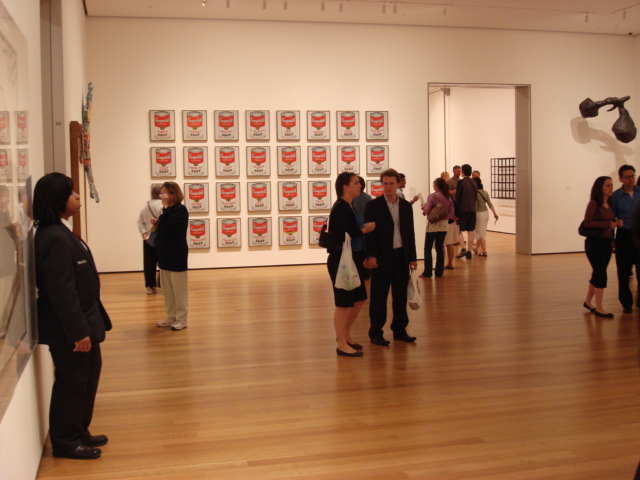
The original soup can paintings are displayed at the Museum of Modern Fine art, New York.
Washington Crossing the Delaware (Emanuel Leutze, 1851)
If there's a painting that every American has seen, it'due south the image of George Washington crossing the Delaware River as a celebration of America'due south war for independence. This painting is featured in history books and in various venues that promote American exceptionalism.
The iconic image of bravery and perseverance displayed in Washing Crossing the Delaware is then famous that it appears on US currency, on the back of the New Bailiwick of jersey State Quarter. It's also been parodied extensively in pop civilisation and political commentary.
There were originally iii versions of this painting, simply the first was on display at the Kunsthalle in Bremen and was destroyed in an air raid during World War Ii. One hung in the West Wing of the White Firm for many years before beingness sold to an art museum.
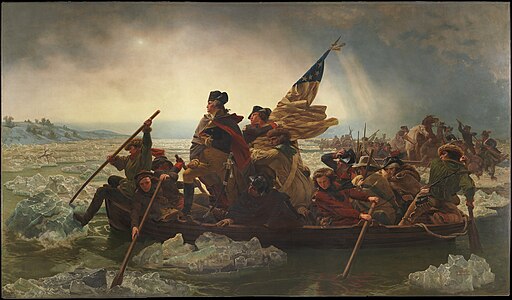
The surviving iterations of Washington Crossing Delaware are on brandish at the Metropolitan Museum of Art, NY, and the Minnesota Marine Art Museum, Winona.
A Sunday Afternoon on the Island of La Grande Jatte (Georges Seurat, 1884-1886)
Everyone recognizes this painting, merely few know the name. Do y'all call up a painting of a spring picnic forth a river, with a woman in the foreground in a black dress with a large bustle, belongings an umbrella? It's eerily reminiscent of impressionist paintings only a tiny bit too crisp to exist considered ane. This is Seurat's A Sunday Afternoon on the Island of La Grande Jatte.
This painting was crafted utilizing the pointillism technique, a form of painting where the artist uses small dots, or points, of color on the canvas to create an overarching image. Seurat was 1 of the outset to use this method and the get-go to execute it on such a large calibration. This work is widely regarded as the start of the neo-impressionist move.
This work is often referenced in pop culture. It'due south appeared in shows such as the Simpson'south and The Office, in motion picture, such equally Ferris Buellers Day Off, and even in video games. A park in Ohio was designed based on the painting, and a 1984 Broadway musical, Sunday in the Park with George, was inspired past the painting.

A Sunday Afternoon on the Isle of La Grande Jatte is on display at the Art Institute, Chicago.
Vitruvian Man (Leonardo DaVinci, 1490)
The Vitruvian Human by Leonardo DaVinci is famous not only for its utilise in popular civilization but for its also for its depiction of human anatomy. As one of the earliest works showcasing realistic proportions, information technology'southward often used as a symbol of modern medicine, wellness, and fitness.
The image portrays a homo with his arms and legs spread, housed inside a circle and a square. It's the earliest realistic depiction of human being proportions in relation to math and anatomy that survives today. Vitruvian Man is often considered a work in science and medicine rather than a work of art.
Though the Vitruvian Man is a drawing rather than a painting, its incorporation into our cultural iconography makes it essential to include on this list. The fact that a cartoon survived for over 500 years and is seared into our collective conscious is a testament to how relevant it really is.

Vitruvian Man is located at the Gallerie Dell'Accademia in Venice but is only displayed every six years to protect the work from damaging light.
American Gothic (Grant Wood, 1930)
Is there anything more ingrained in American cultural imagery than the painting of a homo and woman standing outside their farmhouse, pitchfork in hand? Although many presume that American Gothic portrays husband and married woman, information technology was initially intended to be an image of a father and daughter.
Woods meant the painting to be a celebration of America'due south rural Midwest communities, but many people from the communities were offended by how they were depicted. Yet, as the Not bad Depression grew, the painting morphed into a symbol of America's resiliency. It came to represent the pioneering spirit of Middle America and the resolve to persevere regardless of or even despite the odds.
American Gothic is one of the most parodied paintings in popular culture. Thousands of famous characters have been recreated in front of the farmhouse, from Homer and Marge Simpson to Darth Vader and Princess Leia. The representation is not express to fictional characters, as celebrities, artists, and even political figures have been featured in front end of the farmhouse.
The original imagery is likewise often used to make a political or cultural statement. The original characters have been represented donning masks, using cell phones, dressed for Christmas, or displayed with any number of items intended to brand a statement about the electric current state of the earth.

American Gothic is on display at the Art Institute, Chicago.
The Persistence of Memory (Salvador Dali, 1931)
Amend known as Melting Clocks, the Persistence of Memory created imagery that's now ingrained in the collective consciousness. This surrealist painting depicts various clocks melting in a dreamlike desert landscape. Although ofttimes interpreted to correspond the relative nature of time, Dali himself claimed that his inspiration was cheese melting in the hot sun.
Dali leaned into the fame that the Persistence of Memory brought. He produced a sequel, The Disintegration of the Persistence of Memory, in 1954 and created diverse sculptures and lithographs carrying the aforementioned theme.
The Persistence of Memory is consistently referenced, parodied, and featured in pop culture iconography. It's used to convey dreamlike states and the concept of wasted time. This painting has made appearances in cartoons, video games, and movies and has been parodied with various animals, foodstuffs, and cartoon imagery.

The Persistence of Memory is on display at the Museum of Modern Fine art, New York.
The Scream (Edvard Munch, 1893)
The Scream is 1 of the most well-known and parodied artworks of all time and one of the most important pieces by an creative person who isn't typically well known. The painting depicts a man figure with his easily on his cheeks, screaming on a bridge, with a wild, expressionistic background.
The screaming man appears to be in agony. The painting is often interpreted to symbolize the feet associated with the human condition. Munch himself indicated that feet was the inspiration for this piece, noting that he was overcome with anxiety while out on a walk watching the heaven turn blood red at dusk.
Equally noted, The Scream is 1 of the near parodied works of art. Fictional characters, animals, political figures, cartoons, and near everything you lot tin call back of take replaced the figure portrayed in the original work. It'due south been used to poke fun and convey moods, make viewers laugh, and make them think. Amateur artists often put their original characters on the bridge in place of Munch's original figure. The imagery is replicated repeatedly in both pop civilization and the art globe.

At that place are two versions of The Scream, 1 is on display at the National Gallery, Oslo, and the other is on brandish at the Munch Museum, Oslo.
Sistine Madonna (The Ii Cherubs, Raphael, 1513-1514)
Although the consummate painting, the Sistine Madonna, may non exist seared into our pop culture brains, the paradigm of the ii cherubs at the bottom of the picture is. The cherubs are only a tiny portion of the painting equally a whole, but they appear extensively in pop culture imagery, particularly effectually Valentine'southward Day.
The two cherubs from the Sistine Madonna are the adorable cupids you see on Valentine's Twenty-four hours calendars. They are lying next to each other, each looking rather bored, ane with his mitt on his mentum and the other with his head resting on crossed arms. Both cherubs are looking upwardly, and those familiar with the whole painting will know that they are looking up at the angels in the scene above.

The Sistine Madonna is on display at the Gemaldegalerie Alte Meister, Dresden
The Starry Dark (Vincent Van Gogh, 1889)
Arguably Van Gogh's most famous painting, The Starry Night, is a vivid masterpiece of movement and color. Featuring whirls of blue to represent the night sky and vivid circles of xanthous to represent the moon and the stars, this is 1 of the most widely acclaimed and recognized paintings globally.
Van Gogh painted this masterpiece during a stay at the asylum of Saint-Paul-de-Mausole, where he was existence treated for what nosotros now empathize to be depression and mayhap bipolar disorder. The image likely depicts the view from his window at the asylum, though he fabricated much of the town for the piece.
The Starry Dark imagery is everywhere. It'due south on t-shirts, java mugs, refrigerator magnets, blankets, and anything else people buy and has been referenced in songs, picture, and other artworks. The piece of work is ofttimes parodied, with the tree in the foreground condign either a hero or a villain. Even the hitting game series Super Mario Brothers pays homage to this fantastic piece. "The Painted Swampland" level in Super Mario Wii U was conspicuously inspired past The Starry Dark.
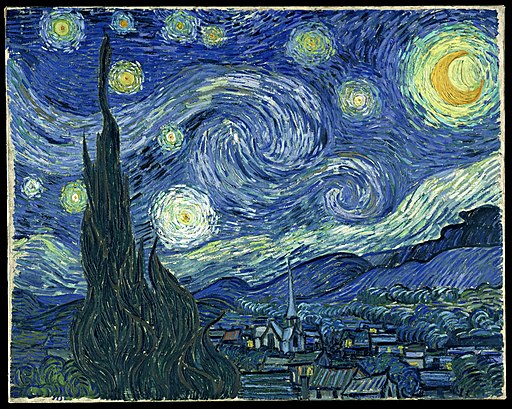
The Starry Night is on display at the Museum of Modern Fine art, New York.
The Creation of Adam (Michelangelo, 1508-1512)
The Creation of Adam is the nearly iconic part of the Sistine Chapel. This fresco, located on the chapel ceiling, depicts the biblical Adam reaching towards, merely non quite touching, the God that just created him.
Commissioned by Pope Julius Ii, The Cosmos of Adam is only ane console in an ballsy masterpiece meant to showcase the biblical story of Genesis visually. The complete painting consists of ix separate panels and covers the unabridged ceiling.
The Creation of Adam is frequently parodied and reproduced in pop culture. Information technology's often used to celebrate a creator, with Jim Henson or Shigeru Miyamoto replacing the god figure and their beloved creations (Kermit the frog and Mario, respectively) replacing Adam. It's also used to poke fun at popular culture or make a political or religious statement. The God-image has been replaced with the Flying Spaghetti Monster, the Adam has been recreated rudely rebuffing God, and cats take replaced both figures in the paradigm.

The Creation of Adam is on brandish at the Sistine Chapel, State of the vatican city.
The Nativity of Venus (Sandro Botticelli, 1480s)
According to myth, the Goddess Aphrodite arose fully formed out of seafoam. The 15th-century painting, Nascence of Venus, is Botticelli's representation of the goddess's arrival on land.
The painting portrays Venus standing atop a giant clamshell, diddled to shore past two lesser gods. An attendant waits on the coast, cloak in mitt, set to encompass the goddess when she arrives. The painting more than aptly showcases the arrival of Venus rather than her nativity, simply information technology was dubbed "The Nativity of Venus" in the 19thursday century, and the name stuck.
As you would await, The Birth of Venus is highly parodied and recreated. Many fictional characters take found themselves in the clamshell, from Ms. Piggy to Black Widow. The imagery is also oftentimes used to celebrate female celebrities. Marilyn Monroe was featured in the clamshell on numerous occasions, and even Beyonce used the painting as inspiration for some maternity photos.
The painting has also been used to make a social statement about cultural dazzler standards. In this version, the Venus is much thinner, and her breasts are larger. Artist Lauren Wade edited a photo of the painting to expose the ridiculous mode that fashion magazines photoshop models to fit their arbitrary standards.

The Birth of Venus is on display at the Uffizi Gallery, Florence.
The Final Supper (Leonardo Da Vinci, 1490s)
The Terminal Supper is undoubtedly the most famous and iconic religious painting ever created. The Duke of Milan commissioned this massive Renaissance mural to renovate the Santa Maria Delle Grazie, a vital area church.
The Last Supper depicts the biblical Jesus dining with his 12 apostles when he breaks the news that ane volition beguile him. Function of the artistry of the slice is the variety of reactions visibly apparent in the apostles. Some react with acrimony, others stupor and disbelief. These emotions are however prominent in the painting even later five centuries.
Every bit such an iconic piece, it'due south no surprise that information technology'due south often recreated in pop culture. Many movies and television shows, from the Simpson's to The Sopranos, have used the imagery of The Last Supper. Although it'southward oft used for promotional purposes, information technology'southward also been used to pay homage to the original work, brand a argument, or poke fun at popular culture.
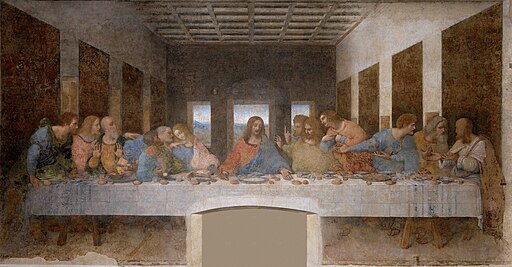
The Last Supper is a mural at the Santa Maria Delle Grazie, Milan.
The Mona Lisa (Leonardo Da Vinci, c 1506)
At that place is no incertitude that the Mona Lisa is the about famous painting of all time. Even people who know zippo about art know of The Mona Lisa. Although the property of the French Republic and not for auction, information technology was insured for equally much as 100 meg dollars back in 1962! If you adjust for aggrandizement, it would be worth over $800 million in today'due south dollars. To put that in perspective, the nigh expensive painting ever sold (according to public records) was bought for about half that, at $450 million.
The Mona Lisa is considered Da Vinci'due south greatest masterpiece. Idea to be a portrait of Italian noblewoman Lisa Gherardini, the painting showcases the idealized version of womanhood celebrated in the Renaissance period. She is poised and noble, yet the corners of her mouth turn up in an almost mysterious smile.
It'due south not just the portrait that makes this work so masterful. The detailed groundwork and perfect blending showcase Da Vinci's expertise. The viewer tin can get a glimpse of a whole different world behind the enigmatic beauty, and this method of exposition in a painting was unheard of for the time.

The Mona Lisa is on display at the Louvre, Paris.
Why Are These the Most Famous Paintings?
It'south challenging to look at humankind's entire body of work over the last thousand years and choice 25 to call the most famous paintings of all time. There are hundreds of other paintings that could take been picked for this list.
These paintings were chosen because they are household names, they are often recreated and parodied in pop culture, or because of their importance and influence in the art world. If you had to make a list of 25 paintings and phone call them the most famous paintings of all time, how many from this list would you include? Which ones would you lot replace, and what would you replace them with?
The amount of influential artwork in the earth is staggering, and although we have to limit our lists of the "best" and "almost important," that isn't meant to take abroad from some of the other notable works of art that didn't make the list.
barcenasjunashe1945.blogspot.com
Source: https://partnersinfire.com/passion-fire-2/art/most-famous-paintings/
0 Response to "The 25 Most Famous Paintings of All Time!"
Post a Comment